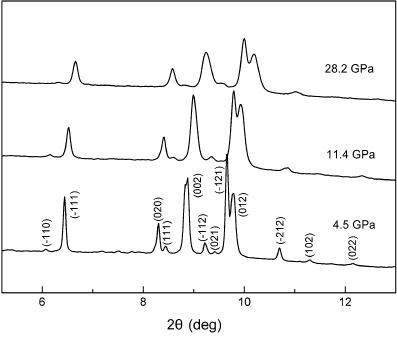Arsenopyrite (FeAsS) is a major ore of arsenic. Its well-formed crystals show a distinct and interesting crystal form. A typical crystal contains a diamond shaped dome atop a prismatic crystal. The crystals have sharp acute angles that are a marked contrast from other sulfides that generally have only obtuse angles. In addition, the connectivity of the atoms in arsenopyrite is somewhat similar to that in marcasite than that in pyrite. Therefore, the compressibility of arsenopyrite at high pressure is very useful to understand the high pressure behavior of sulfide mineral. Prof. ZHOU Wenge’s team at Institute of Geochemistry, CAS (IGCAS) investigated the high-pressure behavior of a natural arsenopyrite using in situ angle-dispersive x-ray diffraction and a diamond anvil cell up to 28.2 GPa.

Fig. Representative X-ray diffraction patterns of arsenopyrite obtained in this study to 28.2 GPa at 300 K
In the research, Prof. ZHOU's team observed no phase change of arsenopyrite up to 28.2 GPa, because as pressure increased, all the peaks shifted continuously toward higher 2θ and the diffraction lines broaden and weaken slightly, but the overall pattern did not change.
They also fitted the axial compression data of arsenopyrite to a linearized third-order Birch Murnaghan equation of state and obtained the axial ratio of the arsenopyrite ranges from 1 to 1.0066 and 0.9973 to 1 for b/a and c/a, respectively, essentially constant at 1, in the present pressure range, confirmed that the linear compressibility (b) along a, b and c directions of arsenopyrite is elastically isotropic.
Since it is the first investigation of the high pressure behavior of arsenopyrite by means of in situ X-ray diffraction at pressures in excess of 25 GPa, Prof. ZHOU’s team made a comparison of their work and the previous studies for pyrite and marcasit, and then found that the bulk modulus of the arsenopyrite in their study is smaller than those of pyrite and marcasite in previous studies. Finally, they inferred that the differences in the elastic behavior of the arsenopyrite, pyrite and marcasite can be attributed to the different compositions and structures since the pyrite has a cubic structure belonging to the Pa3 space group, the marcasite has an orthorhombic structure belonging to the Pmnn, and in contrast, the arsenopyrite has a monoclinic structure with space group P21/c.
Prof. ZHOU's research was supported by the Mutual Foundation of Huge Scientific Equipment of National Natural Science Foundation of China and Chinese Academy of Science and the National Natural Science Foundation of China, and more results have been published in Phys. Chem. Minerals 2011, 38, 95.
The link to the paper: http://www.springerlink.com/content/3747768118090186/
(Provided by FAN Dawei)